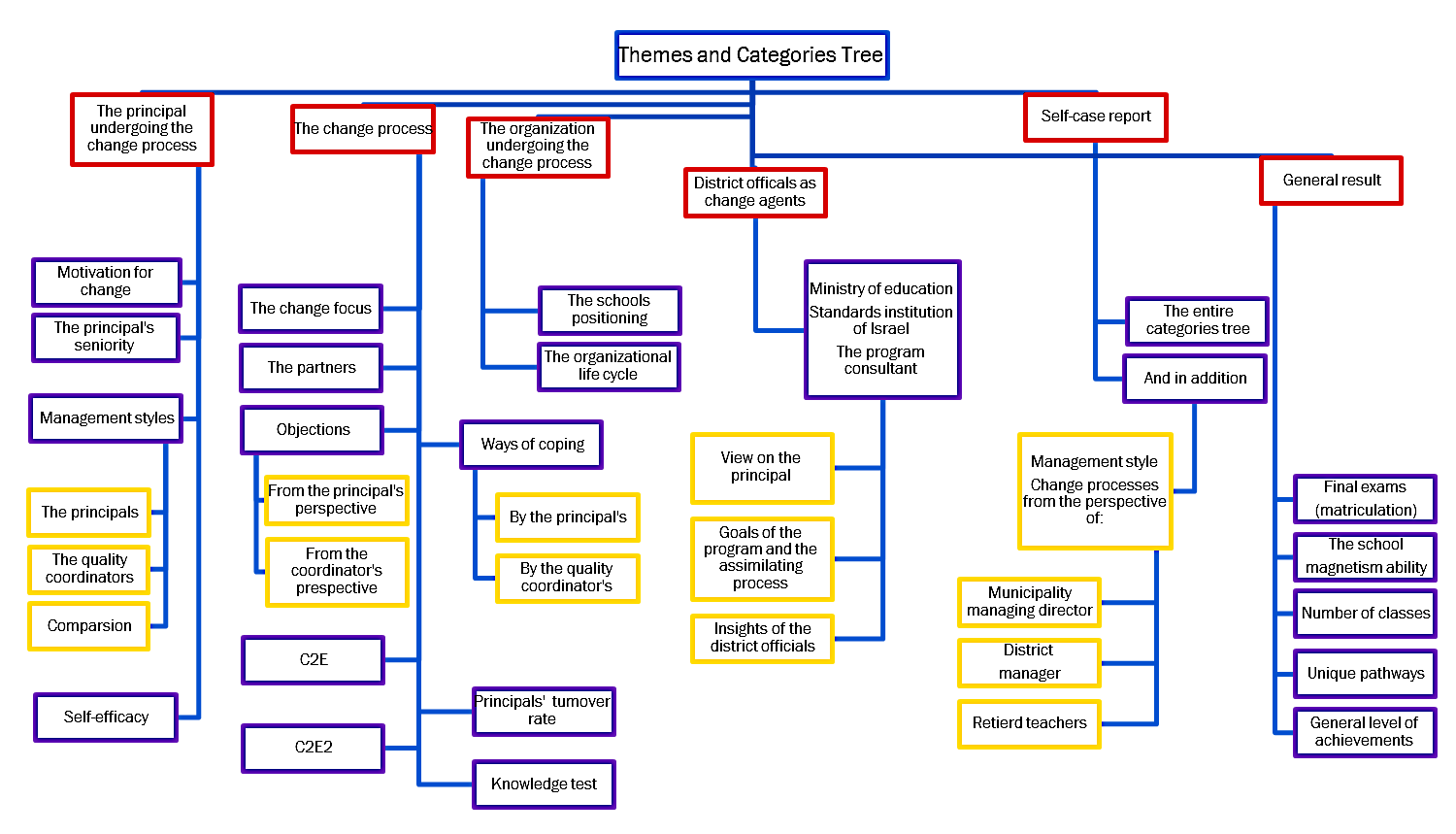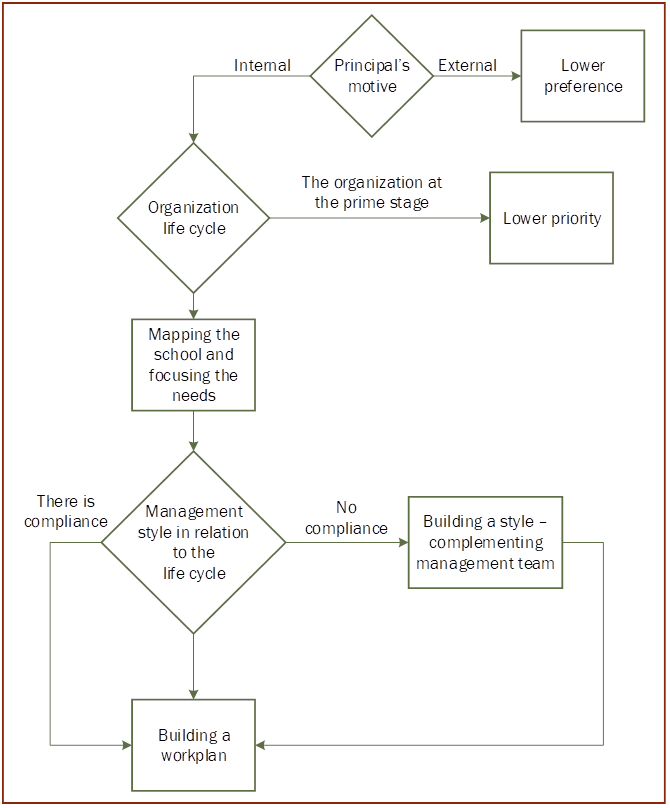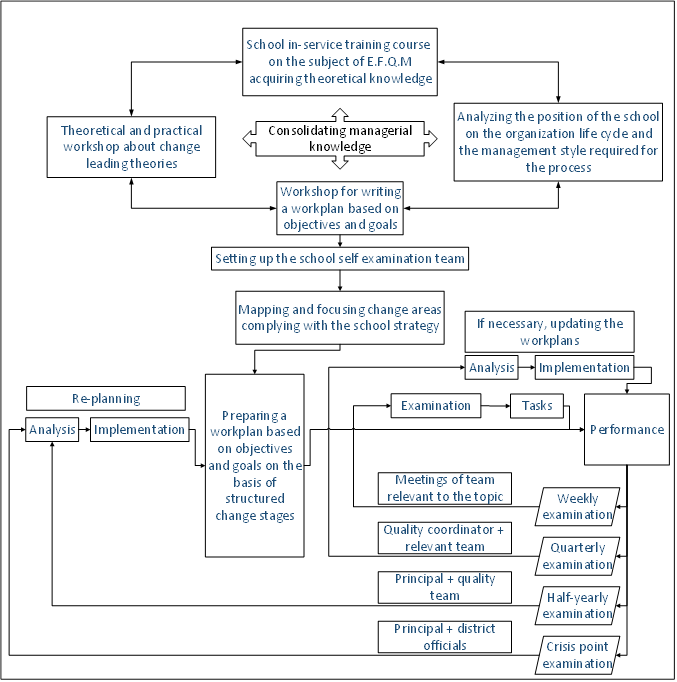Abstract
In recent decades the world has been in the midst of an information and technological revolution affecting all the sectors: industry, economy, the public sphere in general and education systems in particular. Education systems in the Western world are trying to bridge the gap and introduce reforms that are aimed at adapting schools to the changing world. Nobody knows what the future holds for us, but at the same time, it is the responsibility of the education system to prepare the future generation for dealing with this changing reality. There is no doubt that the management of schools on a traditional basis as in the past does not correspond to the current demands and school principals must adapt to flexible management in accordance with the changing reality. Most of the changes generated in education systems fail and the question is how we can implement changes and achieve a a successful assimilation. This paper proposes a model of assimilating changes in education systems, a model that increases the rates of successful change processes and their assimilation. The model was built on the basis of a study conducted among 14 schools in the northern district of the Israeli Ministry of Education. These schools had started the process of assimilating an innovative approach to management, essentially grounded in the E.F.Q.M. approach of the European Foundation for Quality Management.
Keywords: Leading changemanagement stylesEFQMquality and excellence
Introduction
This paper aims to present a study conducted about the assimilation of the E.F.Q.M (European Foundation for Quality Management) organizational excellence approach.
In recent decades, the world has been undergoing a technological revolution followed by the information revolution that is increasingly growing at an exponential rate. This has a far-reaching impact in the sectors of industry, commerce and economy as well as in the public sector in general and in education systems in particular. Education systems in the western world have been trying to bridge the gap between the teaching and learning way and method and the reality resulting from this revolution by introducing reforms designed to adapt the schools to the changing world. No one knows what the future holds in store for us. However, the education system has the responsibility for preparing the future generation for coping with this changing reality. Managing schools on a conventional basis of the past is undoubtedly not suitable for this reality and the principals must adopt a flexible management method in order to accomplish their goal. Organizational changes are handled by the organization managers or by individuals on their behalf who have a management style typical of the managers. Adizes (1980) argues that every stage in the life of the organization requires a different management style. Leading a change in general and in an educational institution in particular constitutes one of the most difficult tasks of principals. Hence, the way of managing the change and assimilating it is crucially important.
This study is grounded in empirical literature and studies that focus on the following topics: change management, management, leadership, self-efficacy, quality, excellence, management style and organizational life cycle. According to Kurt (1951, cited in Fuchs, 2001), Fuchs (1995), Kotter (2003), Levi (2008), Bocos, Radut Taciu, and Chis, (2015) and many others, organizations in general and schools in particular that wish to survive in this competitive world, operate in a world of changes and adaptations to the constantly changing reality. Organization managers in general and principals in particular have to manage the change processes in their organization in an informed manner. The research literature describes processes of change management (Kotter, 2003). This study illustrated that in most schools the process of assimilating the change had failed. This failure of assimilating changes in education systems is in line with various studies (e.g. Kotter, 2003; Harpaz, 2012). These researchers maintain that a considerable percentage (up to80%) of changes and reforms introduced in education systems have failed. Adizes (1980), Fuchs (1995), Sergiovanni (2002), Kotter (2003), Levi (2008) and many others stipulate that managing the change in organizations in general and in schools in particular is a complex practice. This requires management and leadership competences in accordance with the organizational situation, positioning, culture and age. No single person has management and leadership competences that encompass all the management styles and leadership skills needed for flawlessly leading an organization in general and numerous changes in particular. Hence, research theories present the synergetic management that advocates essentially the concept of building management teams. Members of these teams constitute an integrative mix of the features necessary for facilitating the success of the organization in general and the changes transpiring in it in particular. This leads to the conclusion that in the constantly changing reality, whereby the organization is managed during a process of changes, the organization leader should trace a way of managing change processes by means of work teams. Together, these teams will be the required mix of management and leadership styles for leading the change up to its assimilation. Throughout the life cycle of the change, it will be necessary to choose other change leaders from among the team members, in accordance with the stage of the change. The change will begin by a person with a management style of the “E” (Entrepreneur) type, who has initiated the change – usually the organization manager. Afterward, another team member will be in charge, a person with a management style of the “P” (Producer) type, whose role is to produce short-term organization-wide results. Then, the process will be implemented by a team member whose management style is of the “A” (Administrator) type. He or she will have to write work procedures on the basis of which the organization members will function. Finally, a team member whose management style is of the “I” (Integrator) type, will mobilize all the organization members to the task.
Problem Statement
Criticism about the Israeli education system has been voiced by numerous and diversified elements. These bodies included elements inside the education system as well as outside it, e.g. parents, people from the world of academia, State Comptroller Office and others. Many learners in Israel have failed in the international PISA exams, demonstrating poor attainments in nationwide comparative exams and having to cope with challenging educational climate. This raised an important question: Does the education system really educate and form the generation of the future for the 21st century? Has it remained conservative, functioning still along the lines of the 20th century? Unfortunately, it has failed to adapt itself to the students’ constantly transforming learning needs of this century. The status of education system, then, is one of stagnation since it has not made any progress nor has it been transformed. Hence, the district officials of the Ministry of Education northern district have resolved to allocate considerable resources for the purpose of adopting the organizational excellence approach of the European Foundation for Quality Management (E.F.Q.M). Due to this resources allocation, it was decided to investigate the assimilation of this approach in schools. It was also decided to examine the effectiveness of the assimilation and its effect on the school organizational outcomes.
Research Questions
What are the characteristics that promote and inhibit the assimilation of the E.F.Q.M organizational excellence approach in the schools?
Purpose of the Study
This research aims to identify the parameters entailing success or failure in the process of assimilating the E.F.Q.M organizational excellence approach in the schools from the following aspects:
Management styles of the principals and of the quality coordinators and the principals’ self-efficacy.
Processes of assimilating the E.F.Q.M organizational excellence approach in the schools.
Moreover, this study aims to create a platform for educational institutions managers with the purpose of teaching them to lead their organization in the lanes of organizational excellence
Research Methods
This study is based on the mixed method approach, according to which both qualitative and quantitative data are collected. It has also applied the self-case report research instrument. This study investigated the principals and quality coordinators who had together led the change process in their schools. The examination parameters were management styles and self-efficacy and it was done by means of structured questionnaires and a qualitative analysis of their results. Moreover, a sample of teachers responded to a knowledge test in order to check the characterization of the change assimilation among the educational teams. These results were also statistically analyzed. In addition, semi-structured interviews were conducted with the principals and quality coordinators, policy makers of the Ministry of Education as well as both internal and external bodies concerned with leading the change vis-à-vis the schools. The obtained information was analyzed according to themes, categories and sub-categories described in Figure
The researcher (author of this paper) was one of the principals who had assimilated the E.F.Q.M organizational excellence approach in his school. Consequently, the self-case report was chosen as a research instrument, by means of which the researcher examined the school that he managed. The interviewees included retired teachers, managers of the educational network in which the researcher works, employees of the Ministry of Education and of the local authority. The objective was to avoid social desirability as well as obtain a reliable and valid reflection of what is transpiring in the school.

Findings
This study found that 58% of the principals and 66% of the quality coordinators managed the change process in an Administrative type management style. Seventy-five percent of the principals decided to introduce the change into the school without consulting their staff or sharing the decision with them. The objections of the school staff focused on the workload and the multitude of purposeless changes. Eighty-seven percent of the schools successfully completed the first stage of the change assimilation and only 15% continued with the assimilation process towards a further stage of the change. The change management in the schools was not performed on the basis of workplans. On the level of the district officials of the Ministry of Education, the findings indicate that the schools chosen to be the precursors in the assimilation of this change were not chosen due to a certain methodological reason but according to an inconsequential impression of the principal by members of the committee. The officials of the Ministry of Education did not write any comprehensive workplan for assimilating the change over time. Moreover, they did not conduct any thorough inquiry of the situation of the organization and its suitability to the process of assimilating the change. On the level of the school educational and managerial teams, the findings show that they were not versed at all in the topic of the change and its contents.
The Change Assimilation Model
Work processes and change management have a crucial importance for the success of the assimilation process. Consequently, this study proposes a change assimilation model. This model increases the chances of a successful change assimilation by an in-depth and comprehensive building of the change management process both on the principal’s level and on the staff level. Figure No. 2 presents a model for classifying the schools that are suitable to the program.

The district officials should start by checking the principals’ motives with regard to the following questions: Are these motives external and shallow or are they internal, ideological, encompassing in-depth comprehension of the process? Can these motives be enough for cultivating the principals’ degree of motivation and their willingness to assume responsibility for achieving a successful process over a long period of time?
Next comes the issue of the organizational life cycle. The district officials must comprehend and be aware of the organization situation and position on the life cycle curve. They have to diagnose the school in a structured way for the purpose of finding out to what extent the innovative approach is useful and effective for the school at its present stage. Then, the district officials have to identify the school needs and check if this approach can fulfil these needs. After that, the district officials should check, based on structured criteria, the management style of the principals vis-à-vis the school position on its life cycle curve. When the circumstances require it, the principals will be asked to set up a team whose job is to complement the principals’ management styles. Finally, the district officials must prepare a workplan for the principals and their school staff. The plan will outline the objectives the principals have to accomplish, the time frameworks, feedback and control layout and support and assistance to be provided to the principals and the school staff members.
Figure

Firstly, the principals should cope with four preliminary matters before starting the assimilation process in their schools. These preliminary matters are: enhancing the theoretical knowledge, managerial knowledge and organizational analysis on the basis of the criteria that the district official present to the principals. These issues are the foundations and requirements needed for the assimilation of the E.F.Q.M organizational excellence approach. The district officials as well as the principals will make sure at this stage that the situation in which the organization is, complies with the management style of the principals. When required, an official with a management style that complements the management style of the principal will be nominated in order to lead the process.
Secondly, within the framework of the assimilation process, the schools must focus on the change area supporting their strategy. Unlike occurrences in the examined schools, this process aims to determine the priority of change issues that are a change of the second degree. These are topics that can be changed quite easily in a superficial way. The objective of this stage was to prioritize the issues of change, something that was not done until now by the examined schools.
Next, the principals and the relevant staff members should design a workplan consisting of the school aims. This workplan must be coordinated with and authorized by the district officials. Then, a procedure of feedback and control over the process should be prepared. Its role is to introduce on-line changes and if it becomes necessary also to revise the workplans. The objective is to enhance the process so that it becomes an assimilation of the second degree.
To sum up, due to the suggested model, the policy makers can focus their resources in order to improve the inputs. Furthermore, the principals can use the model as a breakthrough, helping them to manage the change and the assimilation thereof. The suggested model includes all the parameters discussed in this study, namely those enhancing the assimilation process and those inhibiting it. It serves as an algorithm for the assimilation of the E.F.Q.M organizational excellence approach in the school.
Conclusion
This study examines the parameters that motivate change assimilation successfully and those that lead to its failure. The parameters are numerous and varied; however, their number can be reduced. This can be achieved by a structured management of change processes as well as by a structured process of examining the preparedness and maturity of the organization for leading a change. The models proposed in this paper, the outcome of this study, serve as a managerial path on the level of the Ministry of Education district officials and on the school level. They offer a safer and more structured way of leading changes so that the extent of uncertainty in this process is minimal and the extent of success greater.
Importance of this Issue
Education systems worldwide in general and in Israel in particular have been investing huge amounts of money in reforms and innovations. Due to the low percentage of success in the assimilation of changes and innovations in education systems, an assimilation model is proposed. Should this model be successfully implemented, then -
Education systems will experience innovativeness and compatibility with the current reality.
Education systems will save a lot of money that could be invested in additional pathways and topics, leading to the systems promotion and enhancement.
The level of trust demonstrated by the internal and external bodies with which the schools work, both on the district officials and school levels, will increase and the extent of objections to innovativeness will decrease.
References
- Adizes, I. (1980). ניהול לקוי, סיבות וטיפול[Deficient management, reasons and handling].Tel Aviv: Tel Aviv University. Cherikover Printing House. [Hebrew]
- Bocos, M., Radut Taciu, R., Chis, O. (2015). Individual changes and organizational change. Exemplifications for the Romanian preschool teaching system. Procedia Social and Behavioral Sciences, 209, 90-95.
- Fuchs, I. (1995). שינוי כדרך חיים במוסדות חינוך [Change – A Way of Life in Schools]. Tel Aviv: Cherikover Publishers. [Hebrew].
- Fuchs, S. (2001). הפסיכולוגיה של ההתנגדות לשינוי [The psychology of objection to change] (4thed.). Ramat Gan: Bar-Ilan University. [Hebrew]
- Harpaz, Y. (2012). After 150 Years, It Is Time to Create a School of Tomorrow, HedHahinuch, February 2012, 29–38. [Hebrew]
- Kotter, J. P. (2003). להוביל שינוי (Leading Change). Tel Aviv: Matar Publishers. [Hebrew].
- Levi, A. (2008). ניהול ומנהיגות שינוי וחדשנות [Management and leadership – change and innovativenesss]. Israel: Rimonim Publications. [Hebrew]
- Sergiovanni, T. J. (2002). ניהול בית ספר, היבטים עיוניים ומעשיים [School Management, Theoretical and Practical Aspects].Tel Aviv: The Open University of Israel Publishers [Hebrew]
Copyright information

This work is licensed under a Creative Commons Attribution-NonCommercial-NoDerivatives 4.0 International License.
About this article
Publication Date
25 June 2019
Article Doi
eBook ISBN
978-1-80296-062-4
Publisher
Future Academy
Volume
63
Print ISBN (optional)
-
Edition Number
1st Edition
Pages
1-613
Subjects
Teacher, teacher training, teaching skills, teaching techniques, special education, children with special needs
Cite this article as:
Shalom, I. B. (2019). Using Smartphone Video Camera to Enhance 1st Grade Pupils Oral Performance Skills. In V. Chis, & I. Albulescu (Eds.), Education, Reflection, Development – ERD 2018, vol 63. European Proceedings of Social and Behavioural Sciences (pp. 520-527). Future Academy. https://doi.org/10.15405/epsbs.2019.06.61

